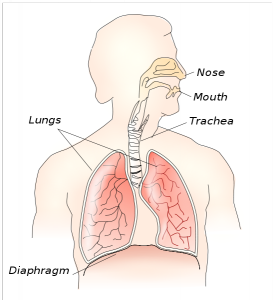Magick 101 #2: Baseball, Breath and Magick
To the ancient Tantric mystics, on average, a simple breath—inhale and exhale—takes about 4 seconds.
That would mean you take about 15 breaths per minute.
That would mean you take about 900 breaths per hour.
That would mean in half a day, 12 hours, you take about 10,800 breaths.
So to the ancient Tantrics, the number 108 can be used to represent the number of breaths you take in half a day. If you say a prayer 108 times, it’s symbolic of praying for half a day. A set of Tantric prayer beads, known as a mala, used to count prayers (and adopted by Hindus) contains 108 beads (plus one more as a marker). To say prayers while going around the beads twice is equivalent to saying prayers for an entire day.
An official Major League baseball has exactly 108 stitches on it. Coincidence?

Maybe.
Or maybe not.
We’ll get back to breathwork in a moment.
Levels of Breath
There are some teachers who will tell you that you’re breathing the wrong way. My advice: forget about them. While there are different levels of breath, each type is valuable for different reasons. What is of value is learning to use the different levels of breathing and being able to access them when appropriate .
HIGH BREATHING:
Imagine you’re a soldier and told to stand at attention:
Stand up straight. Stomach in. Shoulders back. Chest out.
Now try to breathe. It’s hard to do! You have to breathe by expanding and contracting the rib cage. This is done using the small intercostal muscles between the ribs. They weren’t designed to do that.
High breathing limits the amount of air you intake because it only uses the upper part of the lungs. Chronic high breathing may cause digestive problems and is common among people with asthma and by people who wear tight clothes or belts at their waists. High breathing is a natural response to frights and shocks and may trigger the production of hormones necessary for the fight-or-flight response. Not having access to high breathing could result in not being able to handle dangerous situations.
MIDDLE BREATHING:
This is not as clearly defined as high breathing because you have to go through the upper part of the lungs to get to the middle. It will also partially fill the lower part of the lungs. However, middle breathing essentially fills the central part of the lungs. It gives a fuller breath than high breathing but is still not complete. A further difference with high breathing is the movement of the ribs. With high breathing, because the body is held so rigid, the ribs tend to expand upward and forward. With middle breathing they also expand out to the sides.
Because you get more air than with high breathing, middle breathing can be better for you, especially when sitting in a chair. The added breath and oxygen can give you more energy and enhance your concentration abilities over exclusively high breathing.
LOW BREATHING:
This is often described as belly breathing and, according to some teachers, is superior to high and middle breathing. It certainly does have some advantages:
- It uses the deepest part of the lungs, filling and allowing them to naturally clean themselves.
- It massages the organs of the stomach.
- More air is taken in.
- It has a positive effect on the nerves of the solar plexus
- It can provide calmness and courage
This is the style of breathing used by singers and martial artists. It is the most natural form of breathing (watch an infant on its back to see what low breathing looks like). Here’s how it works:
The largest muscle in the body, the diaphragm, separates the upper organs from the stomach organs. When it moves down it creates a bit of a vacuum, causing the lungs to expand and fill with air. When it moves back up, it increases pressure and forces the air out of the lungs. To bring the diaphragm down, imagine your stomach expanding. In fact, let it expand forward. To push the diaphragm up, contract your stomach.
Okay, I know sticking your belly out doesn’t look good to modern Western visual ideals, but concentrate on what you’re doing rather than how you look.
When is this not a “better” form of breathing? Try each of these types of breathing and you’ll see that low breathing takes a lot of time. When you are exercising in a way that raises your pulse and respiration rate, you can’t breathe fast enough using low breathing. It’s not ideal in all situations. It can be used to help calm the mind and spirit.
COMPLETE BREATHING:
This type of breath puts it all together and is primarily used only during breathwork. It combines high, middle, and low breathing. Find a comfortable position. Inhale through your nose for a high breath, expanding your chest up and out. Continue by allowing more breath into your lungs, expanding your chest and ribs to the side. Complete the breath by allowing your stomach to expand, pulling down the diaphragm and filling the lungs completely. Hold the inhalation for a few moments. Don’t strain. Feel comfortable.
Now, exhale slooooooowly through the mouth and nose. Focus on all your muscles and the air leaving you. As you exhale, do not allow your ribcage to relax. Keep it expanded.
Repeat this a few times before you allow yourself to return to normal breathing. With each breath fill your lungs with a smooth movement of air through high, middle and low breaths. Try to lengthen the time it takes you to exhale with each breath. Don’t strain. Go easy. Even a little longer is good.
If you are unsatisfied with the depth and quality of your breathing, there are several devices that can help you improve your breathing capacity. Most look something like this:
They have a mouthpiece and a control for limiting how much air can come into your lungs. You have to inhale more strongly and exhale with greater force. The devices have names like “Ultrabreathe” or “Expand-a-Lung.” All of them can be useful, but be aware that they can be scary at first because it will feel like you can’t get a breath. Relax. Take it easy. Start slow and build up.
Now that we know how to breath for breathwork, how do we get good at it?
And why do it at all?
The Swan
 Photo of Mute Swan by Mindaugas Urbonas
Photo of Mute Swan by Mindaugas Urbonas
Before singing, before language, before grunts, there was breath. If you listen to the breath it has its own sound. When you inhale, the sound is hahm. When you exhale the sound is sah. In the ancient language of Sanskrit, hamsah means “swan.”
Find a comfortable position. As you inhale for a complete breath, hear the breath making the sound “hahm.”
Haaaaaaaaaaahhhhhmmmmmm.
Don’t say anything, just hear it. As you exhale, hear the sound of the breath whispering “sah.”
Saaaaaaaaaaaaahhhhhhhhh.
Focus on the sound and the breath. Why? In the Tantric tradition, the universal and magickal energy, known as praña, is related to the breath. Some teachers mistakenly think it is in the breath. This, however, is not accurate. Praña is triggered by the breath. Praña is not physical, but it can affect the physical plane. The better your ability to generate this energy, this magickal energy, the better your magick will be.
Enhancing the Magickal Energy
Practice working with the complete breath and hearing hamsa in the breath. Reach out with your senses so you can feel or, well, sense the energy you’re working with.
[In Tibetan Tantric Buddhism, rather than hearing hamsa, they begin with the exhalation, which they hear as soh, and follow with the inhalation, which they hear as aham. You may want to try that system using so-aham.]However, the next step is not to merely become aware of the magickal energy, but to enhance it. To do this, begin with the inhalation part of the complete breath. Then rapidly suck in your stomach repeatedly, forcing out brief exhalations. As you do, with each brief exhalation you should hear the sound sah! sah! sah! sah! sah! Do this until you run out of breath and need to inhale.
Be extremely careful with this practice! It can result in hyperventilation, becoming dizzy, and even passing out. This is not the goal! When you begin, spend just two or three minutes performing this exercise. Become aware of the feelings of the energy that course through your body and move in and out with your breath. Feel it increase. Gradually increase your time at this until you can comfortably do this for ten minutes.












[…] Michael Kraig has another excellent post on breathwork. I’ve always admired his ability to make the basics crystal clear, so even someone […]
A little nitpicking: it´s 10800 breaths per 12 hours, not 108000.
Apart from that it´s a great article.
I’ve also found that it is nice to picture wind as you inhale, and water as you exhale.
Thanks for the correction, Trallala! I’ve adjusted it in the post. Thank goodness for readers who keep me on my toes!
The best way I have found to enhance my breathing is Yoga. I’ve never been more aware of my breathing and my stance than I have since practicing Yoga. My meditation and magick work has brought on greater meaning since. I highly recommend Yoga for anyone interested in becomming more in touch with their breathing, their bodies, their whole being.
Thank you for your comment, Martha! I would just like to clarify, however, that what I believe you’re talking about is not “yoga” per se. Rather, it is one form of it known as “hatha yoga.” There are several different types of yoga including Bhakti yoga, Raja yoga, Tantric yoga, etc. For those people who aren’t into hatha yoga, an alternative is the study of a traditional martial art such as Tai Chi, Karate, or Kung Fu, dance, or even classical (technically known as “bel canto”) singing.
Talking about “types of yoga” is kind of like talking about “types of enlightenment” or “types of individuation.” The forms you mention might be thought of as modes of practice, but either it’s yoga or it’s not.